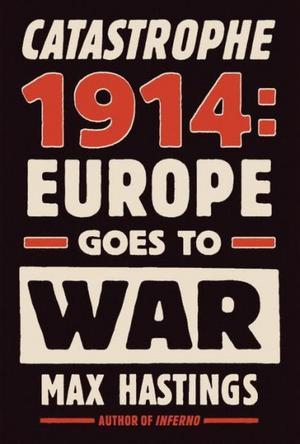By James Srodes
September 23, 2013

If you are as alarmed as I am over how the world’s political leadership — especially our own — seems to be a parade of imbeciles, then invest $35 and read about how the world slid into a similar global catastrophe almost exactly 99 years ago. While history does not repeat itself exactly, this book shows how close it can come.
The British editor and war correspondent Max Hastings over the past two decades has become the contemporary premier historian of 20th-century war. Most of his more than two-dozen books, such as his 2011 masterpiece, “Armageddon,” focus on World War II. But in this large and lavishly illustrated book, he examines just the final six months of a single year when the world descended from an idyllic, albeit unstable, age into the chasm of carnage and upheaval that is known as World War I.
The real strength of this story is how Mr. Hastings portrays the principal characters, not as stereotyped tyrants, greedy empire builders or mindless militarists, but rather as very real human beings with as many flaws as virtues. Most of all, they were prisoners of the times in which they lived and had to make decisions. In other words, a lot like the current crowd.
One of the disturbing echoes for today’s reader is how certain the leaders on both sides of the impending conflict were that the new technologies of warfare would enable them to triumph over their perceived enemies without the traditional cost of the lives of their troops or the destruction of their cities.
Just as today the terrorists who attack Western civilization with random bombing and we reply with drones and “surgical strikes,” so the European elites conjured quick victories conducted by such high-tech marvels as submarines, airships, machine guns and, yes, poison gas as a painless substitute for the brave but bloody infantry charges and cavalry sweeps of the past. In the end, high tech still meant “boots on the ground” — or boots in the mud — were inevitable.
One of the joys of this hefty book is Mr. Hastings‘ narrative skill. He provides the wide-lens approach to the broad political environment, but he spices the long view with attention to the quotidian details of his characters and their inner lives that makes for a very human story. In this, Mr. Hastings is a lot like the French Neo-Impressionist painter Georges Seurat whose pointillist arrangements of dots produced such evocative images.
Mr. Hastings rejects the long-held academic theory that Europe’s leaders were “sleepwalkers” who blundered into World War I by accident. Instead, he shows how all of the major players made what appeared at the time to be carefully thought-out and tough-minded strategic choices that offered considerable strategic gains at little risk. If this sounds familiar, it should.
Another point the author makes that has special resonance these days is that in the years before 1914, there had been an alarming shift in the global balance of power. The result was that the stability the European monarchies and their empires had enjoyed since peace was imposed after Napoleon’s defeat in 1815 was coming unstuck. The Ottoman Empire had imploded already. Throughout Europe and in Great Britain, the rise of Marxist socialism was roiling the working class and turning once-placid parliaments into centers of resistance.
The Hapsburgs of Austria-Hungary felt threatened by the emergence of the new nation of Serbia and the resulting threat of a pan-Slavic revival throughout the Balkans that would ally with Russia. The Romanovs in St. Petersburg had troubles of their own. The czar’s Pacific fleet had been destroyed a decade earlier by the upstart nation of Japan. There had been one revolution already in Russia in 1905 and another could come at any time.
Europe’s newest power nation — Wilhelmine Germany — had become an industrial miracle, but Kaiser Wilhelm felt surrounded by France on one side and Russia on the other. Besides, his industrial barons needed expanded access to raw materials and new markets. Otherwise, the fragile coalition of provinces that Bismarck had put together less than 50 years earlier could come unglued.
Britain, too, was distracted and uneasy. Parts of its vast empire were growing restive, nowhere more so than next door in Ireland, which was on the verge of rebellion. At home, disaffected workers in mines and mills went on strike so often and so violently that troops were increasingly used to force them back to work. The French were changing governments on an almost monthly basis and bet that their alliance with Russia would keep the Germans and Austrians in check.
The assassination of the Hapsburg heir-apparent, Archduke Franz Ferdinand and his wife on June 28, need not have led to war. European royalty faced murder attempts by radicals as an occupational hazard, but the advisers to Emperor Franz Josef convinced him that a quick strike against the Serbs would put the Slavic threat to rest for a while. Call it a “surgical strike.”
In this, the Austrians were urged on by the kaiser, who saw the move as a way to increase Germany’s prestige. The czar responded to Serbia’s plea for help by ordering a troop mobilization — such a move in 1912 had frightened both the Germans and Austrians into silence; surely, it would work again. The French, to show solidarity with the czar, called their troops up, too. The British, who had let their army shrink while building up their navy, sent what troops they could to help the French. The rest is history.
Will the past be prologue? Get this book.
James Srodes’ latest book, “On Dupont Circle” (Counterpoint), has just been released in paperback.
Read more: http://www.washingtontimes.com/news/2013/sep/23/book-review-catastrophe-1914/#ixzz2fzcF2vQd
Follow us: @washtimes on Twitter
No comments:
Post a Comment